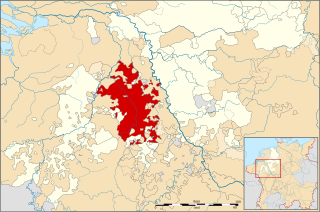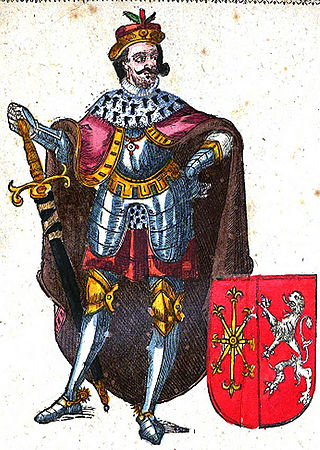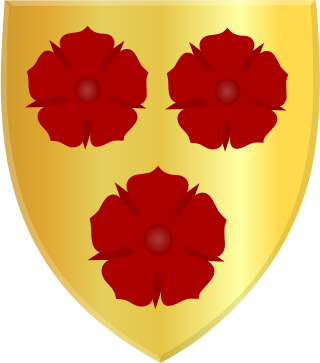Related Research Articles

The County of Loon was a county in the Holy Roman Empire, which corresponded approximately with the modern Belgian province of Limburg. It was named after the original seat of its count, Loon, which is today called Borgloon. During the middle ages the counts moved their court to a more central position in Kuringen, which today forms part of Hasselt, capital of the province.

The Duchy of Jülich comprised a state within the Holy Roman Empire from the 11th to the 18th centuries. The duchy lay west of the Rhine river and was bordered by the Electorate of Cologne to the east and the Duchy of Limburg to the west. It had territories on both sides of the river Rur, around its capital Jülich – the former Roman Iuliacum – in the lower Rhineland. The duchy amalgamated with the County of Berg beyond the Rhine in 1423, and from then on also became known as Jülich-Berg. Later it became part of the United Duchies of Jülich-Cleves-Berg.

The Duchy of Cleves was a state of the Holy Roman Empire which emerged from the medieval Hettergau. It was situated in the northern Rhineland on both sides of the Lower Rhine, around its capital Cleves and the towns of Wesel, Kalkar, Xanten, Emmerich, Rees and Duisburg bordering the lands of the Prince-Bishopric of Münster in the east and the Duchy of Brabant in the west. Its history is closely related to that of its southern neighbours: the Duchies of Jülich and Berg, as well as Guelders and the Westphalian county of Mark. The Duchy was archaically known as Cleveland in English.

Adolph I of Cleves was the second Count of Cleves and the fourth Count of Mark.

The Counts of Vianden, ancestors of the House of Orange-Nassau, were associated with the castle of Vianden in Luxembourg.
The House of Sponheim or Spanheim was a medieval German noble family, which originated in Rhenish Franconia. They were immediate Counts of Sponheim until 1437 and Dukes of Carinthia from 1122 until 1269. Its cadet branches ruled in the Imperial County of Ortenburg-Neuortenburg and various Sayn-Wittgenstein states until 1806.

Berthold III, a member of the Bavarian House of Andechs, was Margrave of Istria from 1173 until his death.
Goswin I of Heinsberg was the Count of Heinsberg from 1085–1128. He was (most-possibly) the father of Goswin II of Heinsberg. He reigned since an unknown period with his brother Gerhard I of Heinsberg. His wife was Oda von Walbeck. He died in 1128 and was succeeded by Goswin II.

Agnes of Austria, a member of the House of Babenberg, was Queen of Hungary from 1168 until 1172 by her first marriage with King Stephen III of Hungary and Duchess of Carinthia by her second marriage with Duke Herman of Carinthia from 1173 until 1181.

The County of Sponheim was an independent territory in the Holy Roman Empire that lasted from the 11th century until the early 19th century. The name comes from the municipality of Sponheim, where the counts had their original residence.

Dietrich VI, also known as Dietrich of Meissen, was Count of Cleves from 1260 until his death in 1275. He was born in about 1226 as the son of Dietrich V, Count of Cleves and Hedwig of Meissen.

Dietrich VII (1256–1305) was Count of Cleves from 1275 through 1305. He was the son of Dietrich VI, Count of Cleves and his wife Aleidis von Heinsberg. Dietrich adopted the strategy used in Holland, in the county of Cleves, methodically reclaiming territory with dikes and settling new residents.

The House of Jülich, German: Haus von Jülich, was a noble House in Germany, operating from the 12th to the 16th century. Its members were initially counts of Jülich, then promoted to dukes of Jülich. By marriage they acquired the duchy of Gelders, which eventually passed to the House of Egmond. They again acquired the counties of Berg & Ravensberg by marriage, and as counts of Berg were elevated to the dukes of Berg; the House became extinct when in 1511 the last male member died and in 1543 the last female died.
Henry II, Lord of Mecklenburg, nicknamed the Lion was regent of Mecklenburg from 1287 to 1298, co-regent from 1298 to 1302 and ruled alone again from 1302 to 1329.
Eberhard I was a German nobleman. He was Count of the Mark from 1277 until his death. He was the son of Engelbert I, Count of the Mark and Kunigunde of Blieskastel, daughter of Count Henry I of Blieskastel.

Dedi III, nicknamed the Fat, a member of the House of Wettin, was Margrave of Lusatia from 1185 until his death.
The Counts of Chiny were part of the nobility of Lotharingia that ruled from the 9th to the 14th century in what is now part of Belgium.
Gottfried III, Count of Sponheim was a German nobleman. He succeeded his father Gottfried II as Count of Sponheim.
Valkenburg or Van Valkenburg is a Dutch toponymic surname indicating an origin in Valkenburg, Dutch Limburg or Valkenburg, South Holland. The name occurs with or without the tussenvoegsel van and has many spelling variants. People with the name include:

The House of Wassenberg, was a noble family, active in the area covering parts of the Netherlands and Germany, active from 1021 until 1371. Residing initially at Wassenberg, they expanded rapidly into larger areas, and grew through marriage.
References
- ↑ Stein 2017, p. 87.
- 1 2 3 4 5 6 Jackman 2013, p. 28.
Books
- Jackman, Donald C. (2013). Gerhard Flamens (Part Two). Editions Enlaplage. ISBN 9781936466641.
- Stein, Robert (2017). Magnanimous Dukes and Rising States: The Unification of the Burgundian Netherlands, 1380-1480. Oxford University Press. p. 87. ISBN 9780198757108.